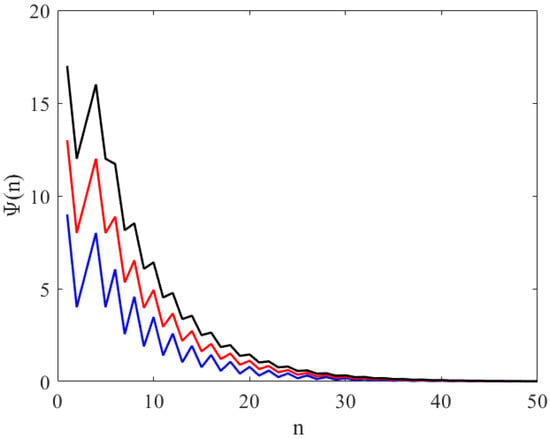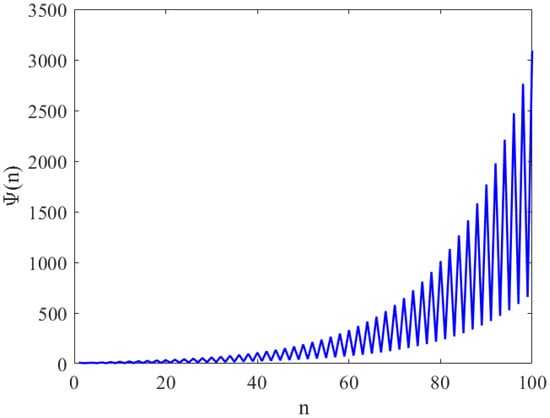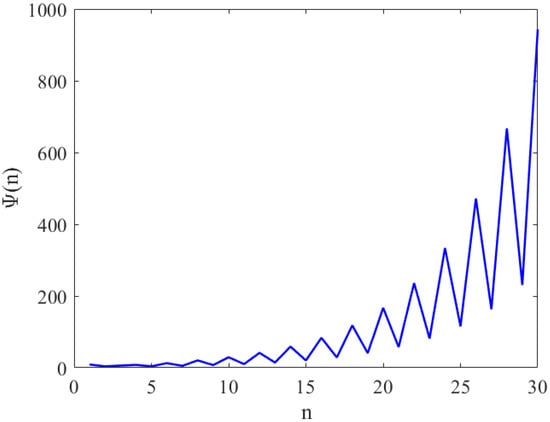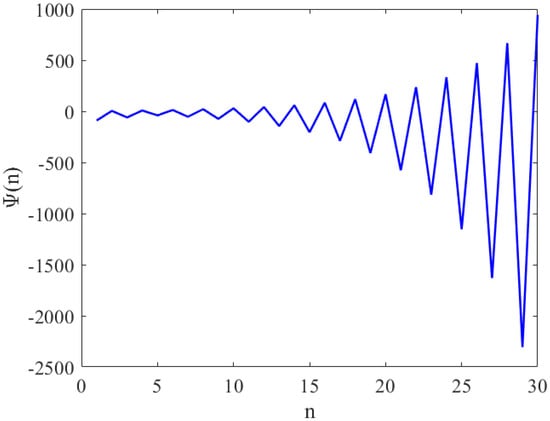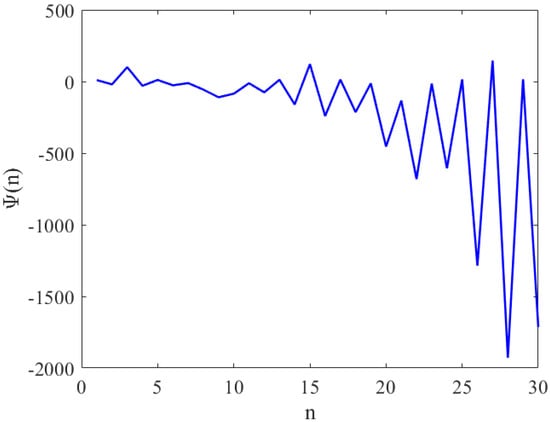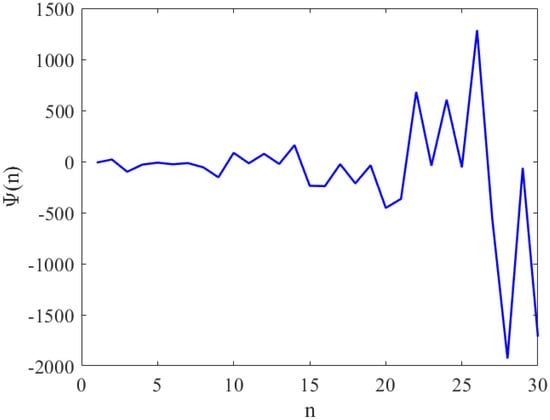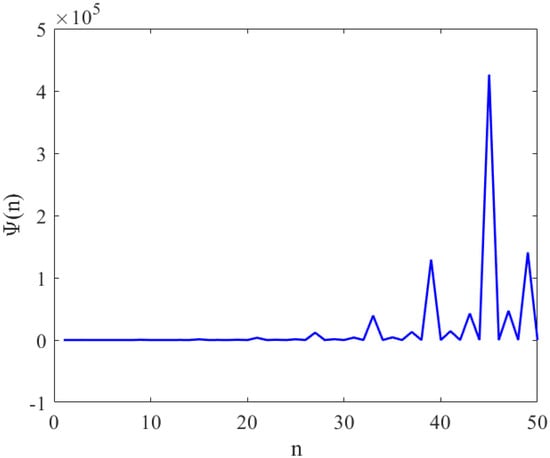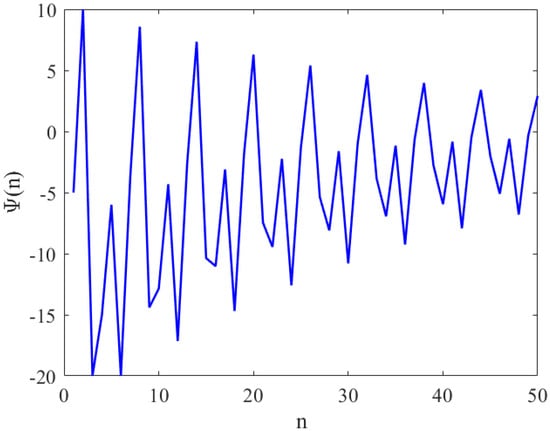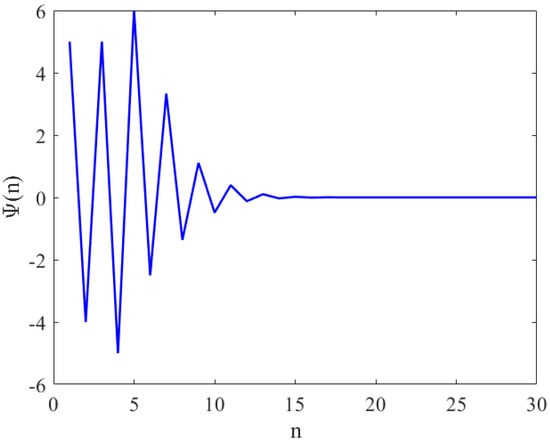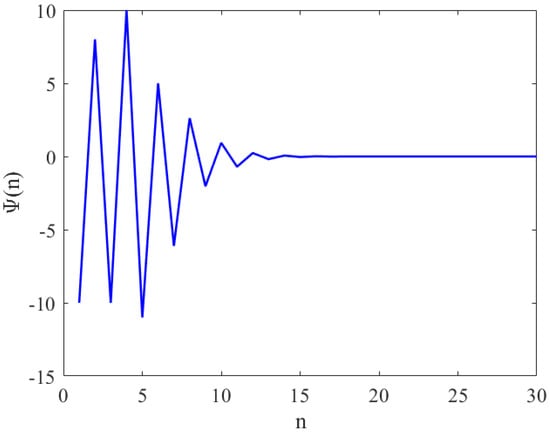Abstract
In this work, we aim to study some qualitative properties of higher order nonlinear difference equations. Specifically, we investigate local as well as global stability and boundedness of solutions of this equation. In addition, we will provide solutions to a number of special cases of the studied equation. Also, we present many numerical examples that support the results obtained. The importance of the results lies in completing the results in the literature, which aims to develop the theoretical side of the qualitative theory of difference equations.
1. Introduction
Consider the difference equation
where the coefficients , are real numbers and the initial values , , are arbitrary positive real numbers. Recently, the study of qualitative properties, such as stability, oscillation, symmetry, and periodicity of solutions of difference equations has attracted the attention of many researchers. This interest is due to the fact that many varied nonlinear phenomena that occur in engineering and the natural sciences are modeled by using forms of difference equations. One such interesting model is the Riccati difference equation
where and are real numbers, and . The richness of Riccati equations’ dynamics is well known [1], and a special instance of these equations gives the famous Beverton–Holt model on the dynamics of exploited fish populations [2]. Kuruklis, et al. analyzed the behavior of Pielou’s discrete logistic model in [3] as another example
where . Pielou developed this equation as a discrete version of the delay logistic differential equation in [4]. In Reference [5], the case in Pielou’s equation was considered. Stevic [6] studied the periodic character of the general equation
where and are positive real numbers and is continuous and satisfies
for some continuous function such that
The asymptotic properties of the nonnegative solutions of the equation
is investigated in [7], where a is a nonnegative real number and f is a continuous function, nondecreasing in each variable and increasing in at least one. Elsayed [8] studied the qualitative behavior of the solution of
The behavior of solutions of
is examined by Ogul, et al. [9]. For more interesting results about techniques and developments in the study of the qualitative behavior of solutions of difference equations, see also [10,11,12,13,14,15,16,17,18]. Also of interest in the study of difference equations is the field of symmetries, as it has many applications in different branches of science [19,20,21].
The results in this paper are divided into two main parts. The first part studies the local and global stability and boundedness of solutions to Equation (1). The second part is concerned with finding solutions to Equation (1) in four special cases. It should be noted that the study of the behavior of solutions of these equations contributes mainly to the theoretical development of the qualitative theory of solutions to difference equations, and this contributes to helping in the study of models resulting from various phenomena. Moreover, the obtainment of solutions to nonlinear difference equations is not prevalent in the works of most of the aforementioned researchers, who are only interested in studying the behavior of solutions.
Next, we provide some definitions and theorems that are essential for presenting our main results.
Let I be some interval of real numbers and let be a continuously differentiable function, where k is a positive integer. Then for every set of initial values the difference equation
has a unique solution . For more, see [5]. A point is called an equilibrium point of Equation (2) if .
Definition 1.
Definition 2.
The linearized Equation (2) of the equilibrium is the linear difference equation
Theorem 1.
See [5]. Assume that and . Then
is a sufficient condition for the asymptotic stability of the difference equation
Remark 1.
Theorem 1 can be easily extended to a general linear equations of the form
where and . Then Equation (4) is asymptotically stable provided that
Theorem 2.
See [5]. Let be an interval of real numbers and assume that
is a continuous function. Then the difference equation has a unique equilibrium and every solution of this equation converges to if the following conditions are satisfied:
(a) is non-decreasing in x and z in for each and is non-increasing in for each x and z in ;
(b) If is a solution of the system
then
2. Stability and Boundedness of Solutions
We study, in this section, the behavior of solution Equation (1). Namely, we investigate the local and global stability, and boundedness of Equation (1).
The equilibrium point of Equation (1) is given by
Therefore
If then is unique equilibrium point. Now, we define the function as
Hence, we obtain
where and are partial derivatives of G.
It follows that
Therefore, the linearized form of Equation (1) becomes
Theorem 3.
Assume that
Proof.
In view of [15] (Theorem 1.1.1), we see that is locally asymptotically stable if
Hence
Then, it follows that
This means that the proof is complete. □
Theorem 4.
If , then the unique equilibrium point of Equation (1) is globally asymptotically stable.
Proof.
We define the function as where are positive real numbers. It is easy to see the function f increasing in z and decreasing in v. Next, taking as the solution to the system
We therefore get
Consequently,
Then,
Therefore, we have
This implies that if . Thus, the equilibrium point of Equation (1) is a global attractor. This means that the proof is complete. □
Theorem 5.
All solutions of Equation (1) are bounded when
Proof.
This means that the sequence is decreasing and hence it is bounded from above by . This means that the proof is complete. □
In the following, we present some numerical simulations to confirm the results of this section.
Example 1.
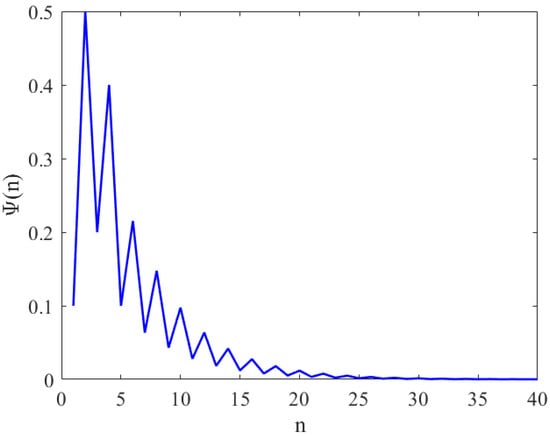
Assume that , , , and with initial condition , , , , and . See Figure 1.

Figure 1.
This figure shows the local stability equilibrium point of Equation (1) with if satisfies the condition of Theorem 1.
3. Solutions of Some Particular Cases
The section introduces solve four particular cases of difference Equation (1).
3.1. Case 1:
Next, we present the solution of difference equation
Theorem 6.
If is the solution to difference Equation (6), then this solution is obtained by the given formulas
where and the sequences and are obtained by the following relations, for
and so
Proof.
It is easy to see that the result holds if . Next, assume that and the assumption holds for , which is
From the formula of difference Equation (6),
After substitution and some simple computation, we obtain
Also, we have
After substitution and some simple computation, we obtain
Moreover, we can prove the other relations. The proof is complete. □
3.2. Case 2:
The subsection introduces solve the following difference equation
Theorem 7.
Proof.
It is easy to see that the result holds if . Next, suppose that and assumption holds for , which is
From the formula of difference Equation (7), we find
Similarly, we have
Also, we can prove the other relations. The proof is complete. □
3.3. Case 3:
The subsection solves the following difference equation
Theorem 8.
If is the solution to difference Equation (8), then this solution is obtained by the given formulas
where and .
Proof.
It is easy to see that the result holds if . Next, assume that and assumption holds for , which is
From the formula difference Equation (8), we arrive at
Similarly, we get
Also, we can prove the other relations. The proof is complete. □
3.4. Case 4:
The subsection introduces solve the following difference equation
Theorem 9.
Proof.
It is easy to see that the result holds if . Next, assume that and assumption holds for , which is
From the formula of difference Equation (9), we obtain
Similarly, we get
Also, we can prove the other relations. The proof is complete. □
4. Conclusions
In this paper, we discussed some properties of solutions of a class of fifth-order rational difference equations. Specifically, we studied the conditions of local and global stability of the equilibrium points, as well as the conditions of boundedness.
It has been verified that condition guarantees the local stability of the equilibrium point of Equation (1). The unique equilibrium point of Equation (1) is a global attractor if . Moreover, every solution of Equation (1) is bounded if Furthermore, we obtained solutions of four special cases of the studied equation which covers most of the possibilities of coefficient signs. Finally, we confirm our results by numerical simulations. It would be interesting to study the oscillatory and periodic behavior of solutions to this Equation (1).
Author Contributions
E.M.E., B.S.A. and O.M. contributed equally to this paper. All authors have read and agreed to the published version of the manuscript.
Funding
This research received no external funding.
Institutional Review Board Statement
Not applicable.
Informed Consent Statement
Not applicable.
Data Availability Statement
Not applicable.
Conflicts of Interest
The authors declare no conflict of interest.
References
- Cull, P.; Flahive, M.; Robson, R. Difference Equations: From Rabbits to Chaos, Undergraduate Texts in Mathematics; Springer: New York, NY, USA, 2005. [Google Scholar]
- Beverton, R.J.H.; Holt, S.J. On the Dynamics of Exploited Fish Populations. In Fishery Investigations Series II; Blackburn Press: Caldwell, NJ, USA, 2004; Volume 19. [Google Scholar]
- Kuruklis, S.; Ladas, G. Oscillation and global attractivity in a discrete delay logistic model. Quart. Appl. Math. 1992, 50, 227–233. [Google Scholar] [CrossRef][Green Version]
- Pielou, E.C. An Introduction to Mathematical Ecology; John Wiley & Sons: New York, NY, USA, 1965. [Google Scholar]
- Kocic, V.L.; Ladas, G. Global Behavior of Nonlinear Difference Equations of Higher order with Applications; Kluwer Academic Publishers: Dordrecht, The Netherlands, 1993. [Google Scholar]
- Stevic, S. The recursive sequence ωn+1 = g(ωn, ωn−1)/(A + ωn). Appl. Math. Lett. 2002, 15, 305–308. [Google Scholar]
- Karakostas, G.L.; Stevic, S. On the recursive sequence ωn+1 = α + ωn−k/f(ωn, ωn−1, …, ωn−k+1). Demonstr. Math. 2005, 3, XXXVIII. [Google Scholar]
- Elsayed, E.M.; Alzahrani, F.; Abbas, I.; Alotaibi, N.H. Dynamical behavior and solution of nonlinear difference equation via fibonacci sequence. J. Appl. Anal. Comput. 2020, 10, 281–288. [Google Scholar] [CrossRef]
- Ogul, B.; Simsek, D.; Ibrahim, T. Solution of the Rational differnce Equation, Dynamics of Continuous. Discrete and Impulsive Systems Series. Appl. Algorit. 2021, 28, 125–141. [Google Scholar]
- Ahmed, E.; Hegazi, A.S.; Elgazzar, A.S. On difference equations motivated by modelling the heart. Nonlinear Dyn. 2006, 46, 49–60. [Google Scholar] [CrossRef][Green Version]
- Chatzarakis, G.E.; Elabbasy, E.M.; Moaaz, O.; Mahjoub, H. Global analysis and the periodic character of a class of difference equations. Axioms 2019, 8, 131. [Google Scholar] [CrossRef]
- Din, Q. Bifurcation analysis and chaos control in discrete-time glycolysis models. J. Math. Chem. 2018, 56, 904–931. [Google Scholar] [CrossRef]
- Elsayed, E.M. New Method to obtain Periodic Solutions of Period Two and Three of a Rational Difference Equation. Nonlinear Dyn. 2015, 79, 241–250. [Google Scholar] [CrossRef]
- Franke, J.E.; Hoag, J.T.; Ladas, G. Global attractivity and convergence to a two-cycle in a difference equation. J. Differ. Eq. Appl. 1999, 5, 203–209. [Google Scholar] [CrossRef]
- Kulenovic, M.R.S.; Ladas, G. Dynamics of Second Order Rational Difference Equations with Open Problems and Conjectures; Chapman & Hall/CRC Press: Boca Raton, FL, USA, 2001. [Google Scholar]
- Moaaz, O. Comment on new method to obtain periodic solutions of period two and three of a rational difference equation. Nonlinear Dyn. 2017, 88, 1043–1049. [Google Scholar] [CrossRef]
- Moaaz, O.; Chalishajar, D.; Bazighifan, O. Some Qualitative Behavior of Solutions of General Class of Difference Equations. Mathematics 2019, 7, 585. [Google Scholar] [CrossRef]
- Moaaz, O.; Chatzarakis, G.E.; Chalishajar, D.; Bazighifan, O. Dynamics of general class of difference equations and population model with two age classes. Mathematics 2020, 8, 516. [Google Scholar] [CrossRef]
- Rasin, O.G.; Hydon, P.E. Symmetries of integrable difference equations on the quad-graph. Stud. Appl. Math. 2007, 119, 253–269. [Google Scholar] [CrossRef]
- Xenitidis, P. Determining the symmetries of difference equations. Proc. R. Soc. A 2018, 474, 20180340. [Google Scholar] [CrossRef]
- Xenitidis, P. Symmetries and conservation laws of the ABS equations and corresponding differential-difference equations of Volterra type. J. Phys. A 2011, 44, 435201. [Google Scholar] [CrossRef][Green Version]
Publisher’s Note: MDPI stays neutral with regard to jurisdictional claims in published maps and institutional affiliations. |
© 2022 by the authors. Licensee MDPI, Basel, Switzerland. This article is an open access article distributed under the terms and conditions of the Creative Commons Attribution (CC BY) license (https://creativecommons.org/licenses/by/4.0/).
